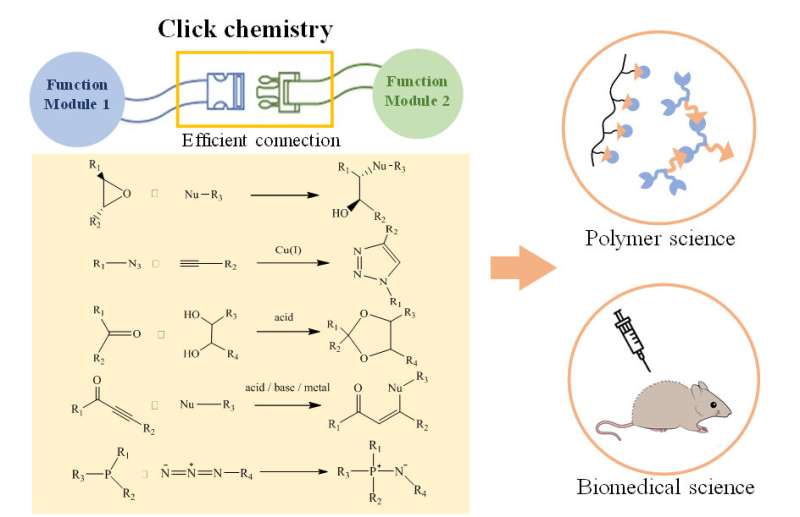This article has been reviewed according to Science X's editorial process and policies. Editors have highlighted the following attributes while ensuring the content's credibility:
fact-checked
trusted source
proofread
Click chemistry as a connection tool: Grand opportunities and challenges

Click chemistry could help to synthesize a variety of molecules quickly and reliably by piecing together small units. In particular, it emphasizes the development of new combinatorial chemistry methods based on the synthesis of carbon-heteroatomic bonds and the simple and efficient acquisition of molecular diversity through these reactions. In this way, it can free scientists from complex molecular synthesis and enable them to focus on the bottom-up linkage of functional modules. However, the different application scenarios in various fields also put forward new requirements for click chemistry.
Recently, a research team led by Prof. Yuan Lu from Tsinghua University, China, reviewed the typical and newly developed click reactions as well as their applications in modern science. The perspective described the development logic of these click reactions. The challenges and potential development directions in this field were also discussed. The results were published in Chinese Journal of Catalysis.
The criteria of click chemistry have instructed us to find several available reaction types, including but not limited to nucleophilic opening, "Protecting Group" reaction, cycloaddition, Michael addition, and Staudinger ligation. These reactions are not perfect at the beginning and still need improvement.
Since the application fields have been broadly enlarged, click reactions should be further developed in two main directions, meaning they should be more condition-relaxed and more intelligent. In this case, strain-activated substrates have been proven to accelerate reactions in the physiological environment. Light-triggered and dissociative click reactions have provided new breakthroughs to make this field smarter and more controllable.
The most amazing ability of click chemistry is to construct a diverse molecular library. This has promoted its application in those fields with complicated research objects, typically polymer and biological science. Click chemistry could facilitate accurate structure control and flexible function modification in polymer synthesis.
It also brings new breakthroughs in bioconjugation, further applied to biomarker/imaging, drug delivery, and drug target screening fields. Notably, although catalysis has played a big role in polymer synthesis, the ideal reactions in physiological systems prefer non-catalysis, which could provide different development logic.
The various application fields have proposed new challenges to click chemistry. Summarily, click reactions should be more biocompatible and easily happen in physiological conditions. They should also be more extensible to facilitate the construction of a molecule library. Smart click chemistry is also encouraged to bring intelligent control to this process.
To address these challenges, the detailed mechanism of click reactions should be clarified, especially in complicated application scenarios. Computer science might provide solutions for constructing a large-scale molecule library and high-throughput screening based on click reactions. Additionally, physical factors, such as light and magnetism, could be introduced as controllable elements, which might promote smart click chemistry.
More information: Chen Wang et al, Click chemistry as a connection tool: Grand opportunities and challenges, Chinese Journal of Catalysis (2023). DOI: 10.1016/S1872-2067(23)64434-1
Provided by Chinese Academy of Sciences





















